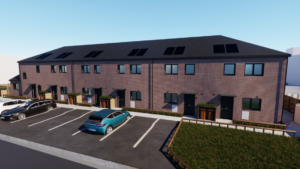Attitudes to specialist housing must change to support ageing population
 As the ageing population in the UK grows, so does the reporting around loneliness, isolation, care scandals and budget cuts. We need to do more to help our older people remain independent, healthy and integrated. It’s important for care providers, developers, local authorities and planners to wake up to the solutions available, particularly around housing.
As the ageing population in the UK grows, so does the reporting around loneliness, isolation, care scandals and budget cuts. We need to do more to help our older people remain independent, healthy and integrated. It’s important for care providers, developers, local authorities and planners to wake up to the solutions available, particularly around housing.
As people grow older, their housing needs change. While vast time and resources are spent to help first time buyers get a foot on the property ladder, last time movers are neglected.
Older people currently occupy nearly a third of all homes and almost 60% of the projected increase of households from 2008-2033 will be owned by someone aged 65 or older. But provision of specialist housing for older people is woefully inadequate and will remain so at current rates of development. A recent Demos report indicated that 33% of the over 60s would be interested in downsizing if they had somewhere suitable to downsize to. We need to be thinking about where this generation of older people can retire to, as well as the next.
With the Health and Social Care Information Centre reporting that one in five older people is lonely or alone for much of the time, integration for older people both at home and in care is key. While some can rely on neighbourhood friends and family for a helping hand, the population of over 85s is set to double in the next 20 years, which means we need to be creating innovative and long term plans now.
Efforts to combat loneliness with technology, phone lines and volunteering are admirable, and important, but older people need and want to live in communities where they can find activities, friends and shops on their doorstep – just like the rest of us.
The government has stated that it wants to make the UK one of the best places to grow old, but this ambition will fail without a major shift in housing policy for older people. We need to boost funding and planning permission for specialist housing for older people and create a real market choice.
Retirement communities and extra care villages provide community for precisely the types of people that might suffer most from loneliness, as they don’t want to call on family and friends when they need more care. The perception of many local authorities is that retirement communities are exclusive gated communities for wealthy retirees, and that they are cut off from the local community, but increasingly retirement communities are providing both the social contact older people need and facilities for the wider community.
The Pannel Croft Village in Birmingham attracts residents from within a one-mile radius and has a diverse resident base. Some 70% of the residents come from the African Caribbean community and the next largest group are Irish residents. The village provides 180 affordable homes (80% rented and 20% shared ownership) and 18 health and social facilities for villagers and the local community. A range of activities involve the wider local community of all age groups such as computer classes, movie nights, gym activities, arts and crafts, karaoke and seaside trips.
Examples such as these should demonstrate that there is huge demand for this kind of housing and that providers have become much more sophisticated in what they are offering older consumers who want to find a home where they can ‘age in place’.
However, to meet that demand a more consistent approach to retirement communities and ‘use classes’ is needed, as often developers are subject to inconsistent charges depending on the local authority and perception of the benefits of these kinds of schemes.
Until we start building more specialist homes for our ageing population we will fall further and further behind in our ability to provide good care. By building at both ends of the housing ladder we will go a long way to ensuring the UK is the best place to grow old.
















The types of housing being built for older people that may eventually have high lack of mobility related needs, is appalling. Everyone is building these hideous apartment style living, where the elderly often end up living in isolation because the wrong mix of people with differing medical issues have been thrown together.
Where we live for example, there is no cognisance taken of the suitability of who goes where in this building, we have people who are totally confined to their wheelchairs put on the upper floors, with the HA depending on the robustness of the fire doors for fire safety. We were trapped during a recent fire with no safe exit route. Although the majority of these apartments are spacious for able bodied singles and couples living here, they are not suitable for full time wheelchair users as they have not be adapted and are not big enough to allow freedom of movement. Some have 2 bathrooms, 1 of which is a very small wet room again not suitable for use by someone dependant on a wheeled shower chair. The showers do not have a temperature safety cut off. Inside the flats there is a mixture of slightly wider doors and normal width doors again not suitable for wheelchair users. The kitchens are modern and well fitted but not accessible by a wheelchair user. The lounges are very small only big enough for a small TV, and 2 armchairs, again not suitable for wheelchair users. There are carpets throughout which is not compatible for wheelchair users. The construction type of the building makes the fitting of ceiling or wall mounted hoists impossible. All internal fire doors are too heavy for independent operation by the majority of wheelchair users. The lift only has controls on one side so many with disabled arms following a stroke etc cannot operate the lifts independently. Management have access to a loud 2-way Tannoy system in each flat which when they cannot be bothered to walk to the flat can noisy intrude on people’s privacy to ask questions of the resident. But this system cannot bizarrely be used during an emergency to offer reassurance to residents when fire alarms are ringing and stress levels are high.
The residents because the HA only make money on residents that need to use their care-workers, are starting to be made up of mainly those with fairly high care needs, making the environment for the minority that are younger, healthier not a good place to live. Someone needs to tackle this issue, getting the mix of needs right in such establishments. The more people you have with dementia the less freedom of movement other residents can have because of the extra security needed etc. Also how these establishments manage smokers and non-smokers . These flats have front doors directly opposite each other, when our fire starting neighbour RIP, used to light up we would get the second hand smoke, not good for a tetraplegic with breathing problems. Walk in a corridor where a resident smokes and you come out of that area stinking of cigarette smoke.
More and more local councils are coming to the conclusion that units like ours are the answer to housing the older population, THEY ARE NOT. They are difficult to adapt to wheelchair use, forcing people to become imprisoned hermits. We need more spacious bungalows to be either adapted or built for older renters.
I have a unique perspective on extra care units as I live with my older disabled husband in one but I am only 47years old. What I do know is that when I am old enough to have to live somewhere like this, I do not want to live somewhere like this ever again. So who are you building these units for , my generation will not put up with being forced to live like this.